本篇文章,聊聊怎么比较稳定的使用 Anthropic Claude 3,以及基于目前表现非常好的模型,来做一些有趣的 AI Native 小工具。
写在前面
在实际体验了半个多月,月初上线的 Anthropic Claude Pro 后,发现 Claude 3 系列模型能力确实很不错(Opus、Sonnet、Haiku),在指令遵循和响应速度上都有比较明显的变化。

不过,个人注册的账号和去年的 ChatGPT Plus 一样,借给朋友体验使用,因为不同的客户端登录(登录 IP 切换),很容易遇到风控问题,比如:需要不确定时间的协助登录确认,更麻烦的会遇到账号封禁,要提工单解除账号限制。
前一阵,亚马逊 AWS 的 Bedrock 基础模型(FM)平台上更新了 Anthropic Claude 3 模型。周末花了一些时间,我对上一篇文章中提到的 Dify 做了一些模型适配工作,现在只需要几条命令,我们就能够通过 Docker 快速地启动一套基于 Claude 3 的 AI 小东西啦,比如 Chat Claude3、Claude3 AI Apps、Claude 3 Bot 的懒人工具啦。
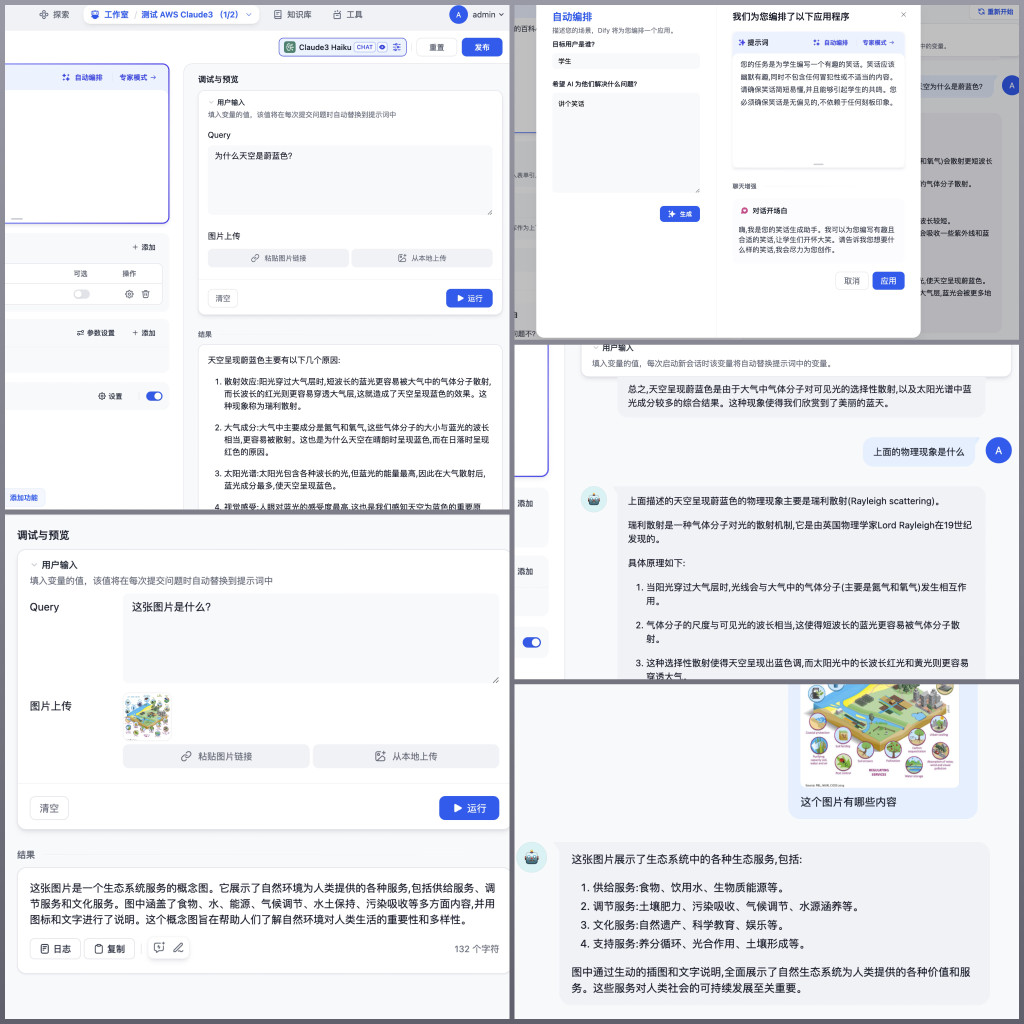
针对 Dify 的相关代码改动已经提交至 Dify 官方仓库,目测官方应用这些功能调整应该还需要一段时间。所以,想快速尝鲜的同学,可以先访问和使用我的仓库来获取配置或者自行构建 Docker 镜像:soulteary/dify。
当然,如果你想使用更现成一些的应用,可以下载网盘中的 Docker 镜像,来快速体验如何分分钟搭建属于你自己的 “Claude3 AI 应用”。
还是先从准备工作开始。
准备工作
需要准备的内容,一共有三项:
- 能够运行 Docker 应用的设备环境(本地或云主机都行)。
- 下载我构建好的 Dify 应用镜像,或使用我提供的源代码仓库进行手动构建。
- 申请亚马逊 AWS Bedrock Claude 3 模型使用权限。
准备工作:Docker 运行环境
借助 Docker,我们能够在投入很少额外资源的情况下,快速获得纯净、可复现的、一致性非常棒的环境。
不论你的设备硬件或云主机是否包含显卡,都可以根据自己的操作系统喜好,参考这两篇来完成基础环境的配置《基于 Docker 的深度学习环境:Windows 篇》、《基于 Docker 的深度学习环境:入门篇》。当然,安装 Docker 之后,还可以做很多其他的有趣的事情,比如:之前几十篇有关 Docker 的实践,在此就不赘述啦。
如果你已经有了一个可以运行 Docker 的环境,我们可以来准备下一项内容。
准备工作:下载或构建修改后的 Dify 应用镜像
晚些时候,我会上传构建好的镜像到网盘,你可以在专栏的评论区找到资源下载地址。镜像下载完毕后,可以使用下面的命令加载镜像:
docker load -i dify-api-claude3.tar
如果你更喜欢从头构建,可以执行下面的命令:
git clone https://github.com/soulteary/dify.git
cd dify/api
git checkout wow/so-lazy
docker build -t soulteary/dify-api:claude3 .
等待命令执行完毕,镜像相关的准备工作就完成啦。
准备工作:AWS Bedrock 的 Claude3 使用权限申请
账号注册等一系列“一路 Next”的简单操作,我们这里就不花时间赘述啦。
当我们登录 “AWS Bedrock”,打开模型访问权限管理页面,默认情况下可能并没有 “Anthropic Claude3” 模型的使用权限。这个时候提交工单申请开通权限即可。
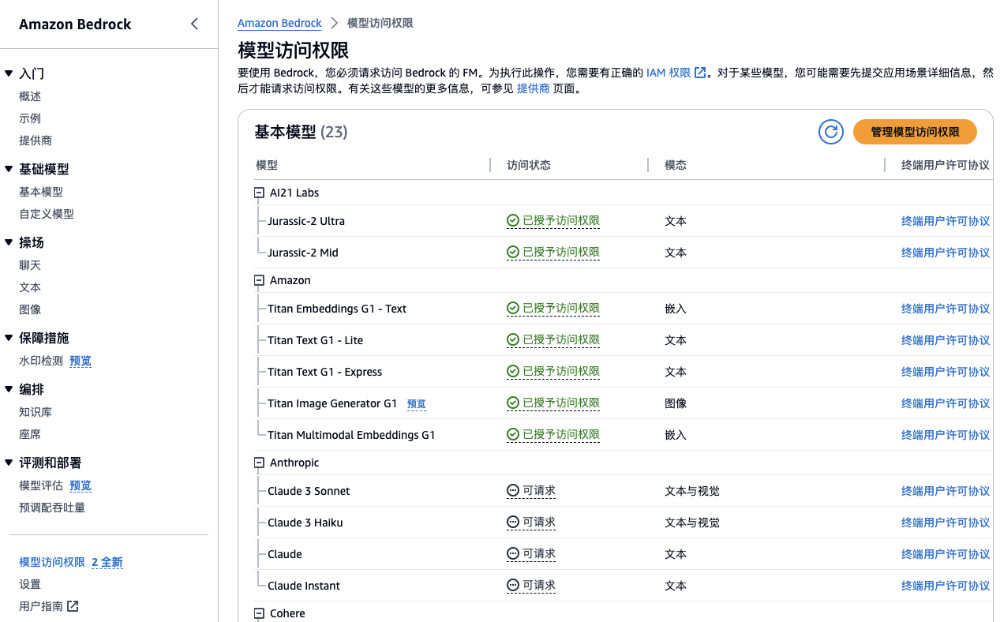
等权限开通后,模型权限页面就能够看到“一切就绪”啦。
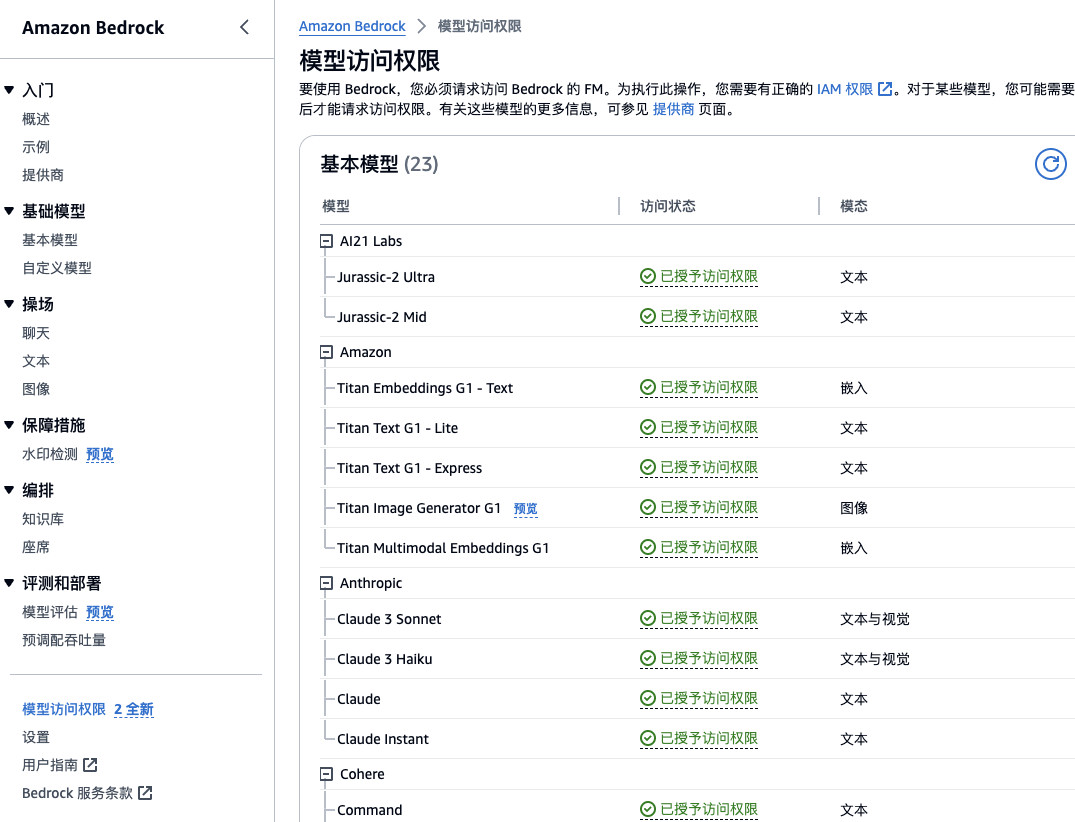
访问“用户凭证管理”页面,创建一个凭证后,下载凭证文件(credentials)后,我们的准备工作就都完成啦。
实践开始
这里同样包括三个步骤:
- 使用 Docker 启动 Dify,完成应用基础配置,让我们能够在浏览器中管理和配置后续搭建的具体 AI 应用。
- 在 Dify 里完成 Claude3 或者其他的模型资源的配置,让我们的程序能够调用这些模型来进行内容生成。
- 使用 Dify 简单的折腾几个常见应用,比如 ChatBot,最简单的知识库。
快速完成 Dify 的配置和启动
想要快速的使用 Docker 启动 Dify,我们只需要准备两个文件,分别是 Docker 编排文件 docker-compose.yml 和 Nginx 配置文件nginx.conf。
version: '3.1'
services:
# API service
api:
image: soulteary/dify-api:claude3
restart: always
environment:
# Startup mode, 'api' starts the API server.
MODE: api
# The log level for the application. Supported values are `DEBUG`, `INFO`, `WARNING`, `ERROR`, `CRITICAL`
LOG_LEVEL: INFO
# A secret key that is used for securely signing the session cookie and encrypting sensitive information on the database. You can generate a strong key using `openssl rand -base64 42`.
SECRET_KEY: sk-9f73s3ljTXVcMT3Blb3ljTqtsKiGHXVcMT3BlbkFJLK7U
# The base URL of console application web frontend, refers to the Console base URL of WEB service if console domain is
# different from api or web app domain.
# example: http://cloud.dify.ai
CONSOLE_WEB_URL: ''
# Password for admin user initialization.
# If left unset, admin user will not be prompted for a password when creating the initial admin account.
INIT_PASSWORD: ''
# The base URL of console application api server, refers to the Console base URL of WEB service if console domain is
# different from api or web app domain.
# example: http://cloud.dify.ai
CONSOLE_API_URL: ''
# The URL prefix for Service API endpoints, refers to the base URL of the current API service if api domain is
# different from console domain.
# example: http://api.dify.ai
SERVICE_API_URL: ''
# The URL prefix for Web APP frontend, refers to the Web App base URL of WEB service if web app domain is different from
# console or api domain.
# example: http://udify.app
APP_WEB_URL: ''
# File preview or download Url prefix.
# used to display File preview or download Url to the front-end or as Multi-model inputs;
# Url is signed and has expiration time.
FILES_URL: ''
# When enabled, migrations will be executed prior to application startup and the application will start after the migrations have completed.
MIGRATION_ENABLED: 'true'
# The configurations of postgres database connection.
# It is consistent with the configuration in the 'db' service below.
DB_USERNAME: postgres
DB_PASSWORD: difyai123456
DB_HOST: db
DB_PORT: 5432
DB_DATABASE: dify
# The configurations of redis connection.
# It is consistent with the configuration in the 'redis' service below.
REDIS_HOST: redis
REDIS_PORT: 6379
REDIS_USERNAME: ''
REDIS_PASSWORD: difyai123456
REDIS_USE_SSL: 'false'
# use redis db 0 for redis cache
REDIS_DB: 0
# The configurations of celery broker.
# Use redis as the broker, and redis db 1 for celery broker.
CELERY_BROKER_URL: redis://:difyai123456@redis:6379/1
# Specifies the allowed origins for cross-origin requests to the Web API, e.g. https://dify.app or * for all origins.
WEB_API_CORS_ALLOW_ORIGINS: '*'
# Specifies the allowed origins for cross-origin requests to the console API, e.g. https://cloud.dify.ai or * for all origins.
CONSOLE_CORS_ALLOW_ORIGINS: '*'
# The type of storage to use for storing user files. Supported values are `local` and `s3`, Default: `local`
STORAGE_TYPE: local
# The path to the local storage directory, the directory relative the root path of API service codes or absolute path. Default: `storage` or `/home/john/storage`.
# only available when STORAGE_TYPE is `local`.
STORAGE_LOCAL_PATH: storage
# The S3 storage configurations, only available when STORAGE_TYPE is `s3`.
S3_ENDPOINT: 'https://xxx.r2.cloudflarestorage.com'
S3_BUCKET_NAME: 'difyai'
S3_ACCESS_KEY: 'ak-difyai'
S3_SECRET_KEY: 'sk-difyai'
S3_REGION: 'us-east-1'
# The type of vector store to use. Supported values are `weaviate`, `qdrant`, `milvus`.
VECTOR_STORE: weaviate
# The Weaviate endpoint URL. Only available when VECTOR_STORE is `weaviate`.
WEAVIATE_ENDPOINT: http://weaviate:8080
# The Weaviate API key.
WEAVIATE_API_KEY: WVF5YThaHlkYwhGUSmCRgsX3tD5ngdN8pkih
# Mail configuration, support: resend, smtp
MAIL_TYPE: ''
# default send from email address, if not specified
MAIL_DEFAULT_SEND_FROM: 'YOUR EMAIL FROM (eg: no-reply <no-reply@dify.ai>)'
SMTP_SERVER: ''
SMTP_PORT: 587
SMTP_USERNAME: ''
SMTP_PASSWORD: ''
SMTP_USE_TLS: 'true'
# the api-key for resend (https://resend.com)
RESEND_API_KEY: ''
RESEND_API_URL: https://api.resend.com
# The DSN for Sentry error reporting. If not set, Sentry error reporting will be disabled.
SENTRY_DSN: ''
# The sample rate for Sentry events. Default: `1.0`
SENTRY_TRACES_SAMPLE_RATE: 1.0
# The sample rate for Sentry profiles. Default: `1.0`
SENTRY_PROFILES_SAMPLE_RATE: 1.0
depends_on:
- db
- redis
volumes:
# Mount the storage directory to the container, for storing user files.
- ./volumes/app/storage:/app/api/storage
# worker service
# The Celery worker for processing the queue.
worker:
image: soulteary/dify-api:claude3
restart: always
environment:
# Startup mode, 'worker' starts the Celery worker for processing the queue.
MODE: worker
# --- All the configurations below are the same as those in the 'api' service. ---
# The log level for the application. Supported values are `DEBUG`, `INFO`, `WARNING`, `ERROR`, `CRITICAL`
LOG_LEVEL: INFO
# A secret key that is used for securely signing the session cookie and encrypting sensitive information on the database. You can generate a strong key using `openssl rand -base64 42`.
# same as the API service
SECRET_KEY: sk-9f73s3ljTXVcMT3Blb3ljTqtsKiGHXVcMT3BlbkFJLK7U
# The configurations of postgres database connection.
# It is consistent with the configuration in the 'db' service below.
DB_USERNAME: postgres
DB_PASSWORD: difyai123456
DB_HOST: db
DB_PORT: 5432
DB_DATABASE: dify
# The configurations of redis cache connection.
REDIS_HOST: redis
REDIS_PORT: 6379
REDIS_USERNAME: ''
REDIS_PASSWORD: difyai123456
REDIS_DB: 0
REDIS_USE_SSL: 'false'
# The configurations of celery broker.
CELERY_BROKER_URL: redis://:difyai123456@redis:6379/1
# The type of storage to use for storing user files. Supported values are `local` and `s3`, Default: `local`
STORAGE_TYPE: local
STORAGE_LOCAL_PATH: storage
# The type of vector store to use. Supported values are `weaviate`, `qdrant`, `milvus`.
VECTOR_STORE: weaviate
# The Weaviate endpoint URL. Only available when VECTOR_STORE is `weaviate`.
WEAVIATE_ENDPOINT: http://weaviate:8080
# The Weaviate API key.
WEAVIATE_API_KEY: WVF5YThaHlkYwhGUSmCRgsX3tD5ngdN8pkih
# Mail configuration, support: resend
MAIL_TYPE: ''
# default send from email address, if not specified
MAIL_DEFAULT_SEND_FROM: 'YOUR EMAIL FROM (eg: no-reply <no-reply@dify.ai>)'
# the api-key for resend (https://resend.com)
RESEND_API_KEY: ''
RESEND_API_URL: https://api.resend.com
depends_on:
- db
- redis
volumes:
# Mount the storage directory to the container, for storing user files.
- ./volumes/app/storage:/app/api/storage
# Frontend web application.
web:
image: langgenius/dify-web:0.5.9
restart: always
environment:
EDITION: SELF_HOSTED
# The base URL of console application api server, refers to the Console base URL of WEB service if console domain is
# different from api or web app domain.
# example: http://cloud.dify.ai
CONSOLE_API_URL: ''
# The URL for Web APP api server, refers to the Web App base URL of WEB service if web app domain is different from
# console or api domain.
# example: http://udify.app
APP_API_URL: ''
# The DSN for Sentry error reporting. If not set, Sentry error reporting will be disabled.
SENTRY_DSN: ''
# The postgres database.
db:
image: postgres:15-alpine
restart: always
environment:
PGUSER: postgres
# The password for the default postgres user.
POSTGRES_PASSWORD: difyai123456
# The name of the default postgres database.
POSTGRES_DB: dify
# postgres data directory
PGDATA: /var/lib/postgresql/data/pgdata
volumes:
- ./volumes/db/data:/var/lib/postgresql/data
healthcheck:
test: [ "CMD", "pg_isready" ]
interval: 1s
timeout: 3s
retries: 30
# The redis cache.
redis:
image: redis:6-alpine
restart: always
volumes:
# Mount the redis data directory to the container.
- ./volumes/redis/data:/data
# Set the redis password when startup redis server.
command: redis-server --requirepass difyai123456
healthcheck:
test: [ "CMD", "redis-cli", "ping" ]
# The Weaviate vector store.
weaviate:
image: semitechnologies/weaviate:1.19.0
restart: always
volumes:
# Mount the Weaviate data directory to the container.
- ./volumes/weaviate:/var/lib/weaviate
environment:
# The Weaviate configurations
# You can refer to the [Weaviate](https://weaviate.io/developers/weaviate/config-refs/env-vars) documentation for more information.
QUERY_DEFAULTS_LIMIT: 25
AUTHENTICATION_ANONYMOUS_ACCESS_ENABLED: 'false'
PERSISTENCE_DATA_PATH: '/var/lib/weaviate'
DEFAULT_VECTORIZER_MODULE: 'none'
CLUSTER_HOSTNAME: 'node1'
AUTHENTICATION_APIKEY_ENABLED: 'true'
AUTHENTICATION_APIKEY_ALLOWED_KEYS: 'WVF5YThaHlkYwhGUSmCRgsX3tD5ngdN8pkih'
AUTHENTICATION_APIKEY_USERS: 'hello@dify.ai'
AUTHORIZATION_ADMINLIST_ENABLED: 'true'
AUTHORIZATION_ADMINLIST_USERS: 'hello@dify.ai'
# The nginx reverse proxy.
# used for reverse proxying the API service and Web service.
nginx:
image: nginx:latest
restart: always
volumes:
- ./nginx.conf:/etc/nginx/nginx.conf
depends_on:
- api
- web
ports:
- "80:80"
上面是 docker-compose.yml 文件的内容,保存在 soulteary/dify/docker/docker-compose.yml,默认配置中我们将使用 Nginx 将各种服务串起来,在 80 端口提供访问服务。你可以根据你自己的需求,来进行配置调整。当然,如果你是 traefik 用户,可以参考这个配置文件:soulteary/dify/docker/docker-compose.traefik.yml。搞定 Docker 配置后,大概完成了这个阶段 50% 的工作。
让我们继续来完成剩下 50% 的工作,在 docker-compose.yml 相同目录下,创建一个名为 nginx.conf 的文件(soulteary/dify/docker/nginx.conf):
user nginx;
worker_processes auto;
error_log /var/log/nginx/error.log notice;
pid /var/run/nginx.pid;
events {
worker_connections 1024;
}
http {
include /etc/nginx/mime.types;
default_type application/octet-stream;
log_format main '$remote_addr - $remote_user [$time_local] "$request" '
'$status $body_bytes_sent "$http_referer" '
'"$http_user_agent" "$http_x_forwarded_for"';
access_log /var/log/nginx/access.log main;
sendfile on;
keepalive_timeout 65;
client_max_body_size 15M;
server {
listen 80;
server_name _;
proxy_set_header Host $host;
proxy_set_header X-Forwarded-For $proxy_add_x_forwarded_for;
proxy_set_header X-Forwarded-Proto $scheme;
proxy_http_version 1.1;
proxy_set_header Connection "";
proxy_buffering off;
proxy_read_timeout 3600s;
proxy_send_timeout 3600s;
location @backend {
proxy_pass http://api:5001;
}
location @frontend {
proxy_pass http://web:3000;
}
location /console/api {
try_files $uri $uri/ @backend;
}
location /api {
try_files $uri $uri/ @backend;
}
location /v1 {
try_files $uri $uri/ @backend;
}
location /files {
try_files $uri $uri/ @backend;
}
location / {
try_files $uri $uri/ @frontend;
}
}
}
创建并保存了上面两个配置文件后,我们执行 docker compose up -d,稍等片刻,等待服务运行完毕,就能够在浏览器中访问 Dify 啦。
# docker compose up -d
[+] Running 7/7
✔ Container docker-weaviate-1 Started 0.6s
✔ Container docker-web-1 Started 0.6s
✔ Container docker-db-1 Started 0.8s
✔ Container docker-redis-1 Started 0.7s
✔ Container docker-worker-1 Started 1.0s
✔ Container docker-api-1 Started 1.0s
✔ Container docker-nginx-1 Started
当 Docker 中的程序都跑起来之后,我们在浏览器中访问运行 Docker 程序的设备 IP 和端口,比如: http://IP:80 ( 本地运行的话,会是http://127.0.0.1),就能够看到 Dify 的管理员账号设置界面啦。
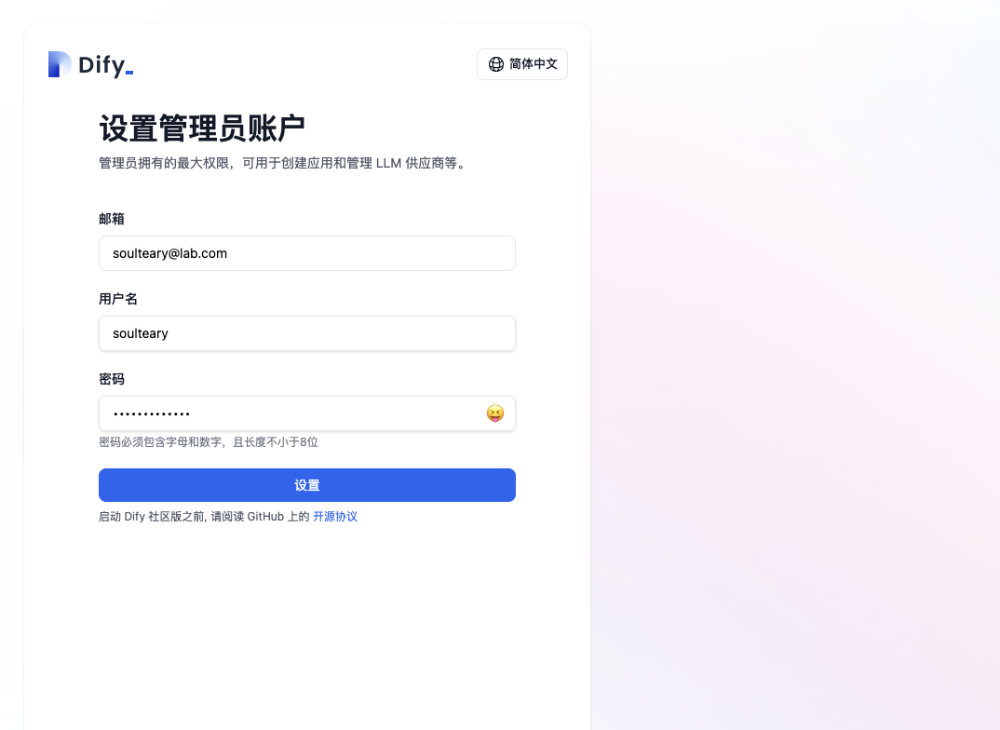
设置完毕管理员账号后,登录程序,就能够访问 Dify 的控制面板啦,我们可以在这里随意的创建基于 Prompt 的 AI 应用。
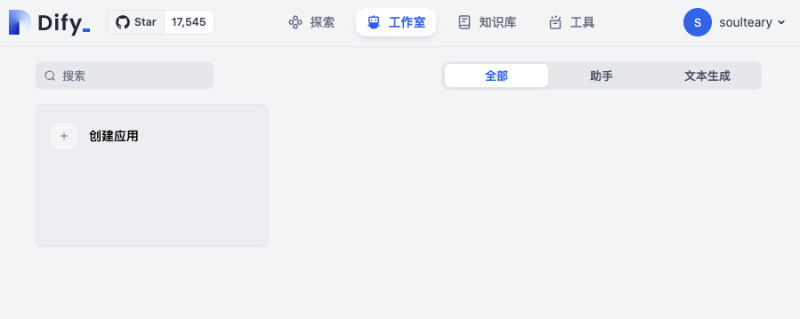
当然,在搭建 AI 应用前,我们还需要进行一个步骤,配置可以使用的模型资源。
配置 Claude 3 等模型服务
点击界面右上角的用户头像,在下拉菜单中点击“设置”,在弹出窗口中选择左侧的“模型供应商”菜单,能够看到 Dify 支持配置使用的所有模型类型。
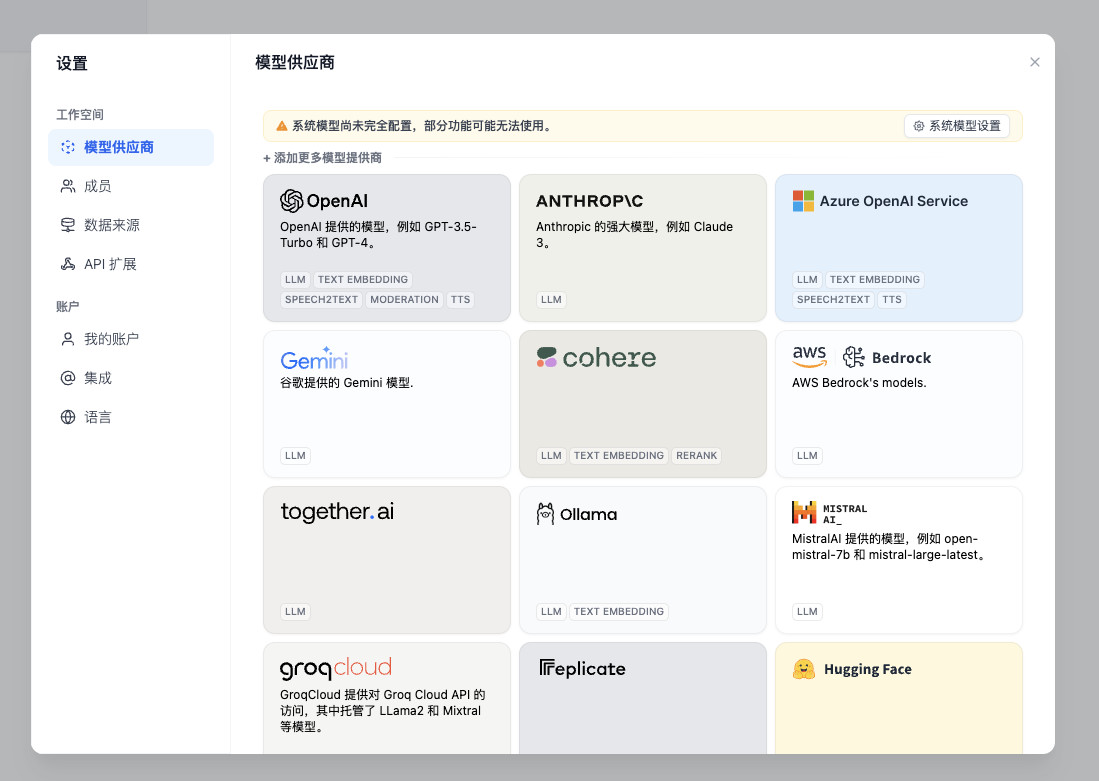
如果你的 AWS Claude 3 模型使用权限申请就绪,那么可以点击 “AWS Bedrock” 模型,打开设置界面。
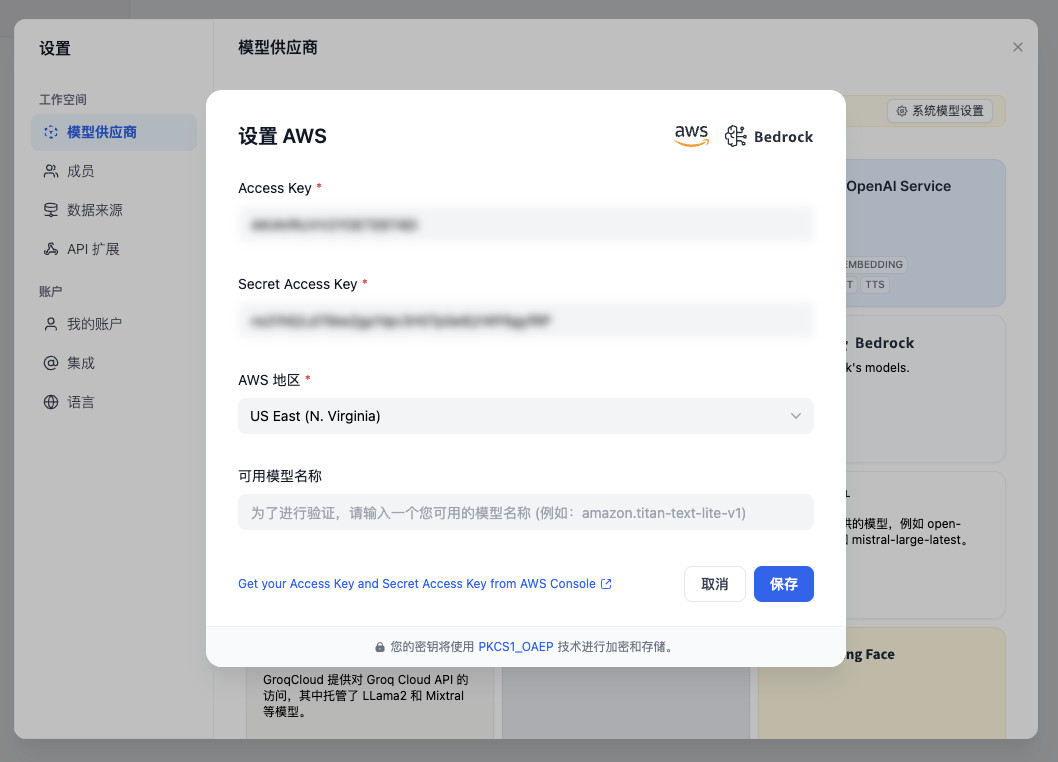
在设置页面中,填写我们从上文中获取到的 AWS 用户凭据信息(Access Key 和 Secret Access Key),你开通资源访问的云服务资源区域,如果你没有获取所有的模型访问权限,为了能够配置成功,你需要在界面最后一栏中填写一个你拥有权限的模型名称。

全部配置结束后,点击“模型供应商”这个弹窗顶部的“系统模型设置”按钮,在弹出的下拉菜单中,更新默认的系统推理模型,建议选择能力相对比较强的模型,可以大幅提升你使用 Dify 过程中的用户体验。
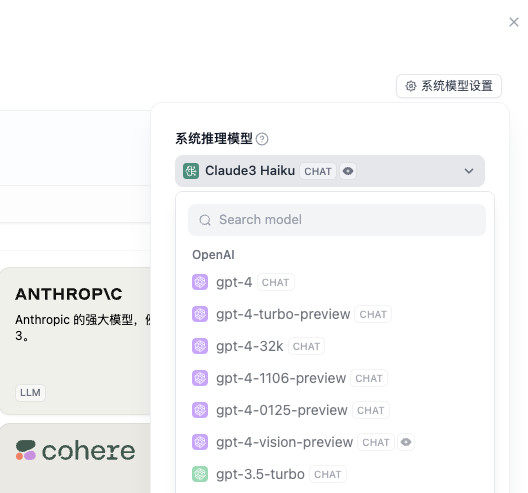
好啦,接下来我们就可以正式开始搭建 AI 应用啦。
先快速搭建一个 AI 应用
回到主界面,点击“创建应用”按钮,能够看到一个“开始创建一个新应用”的弹窗。
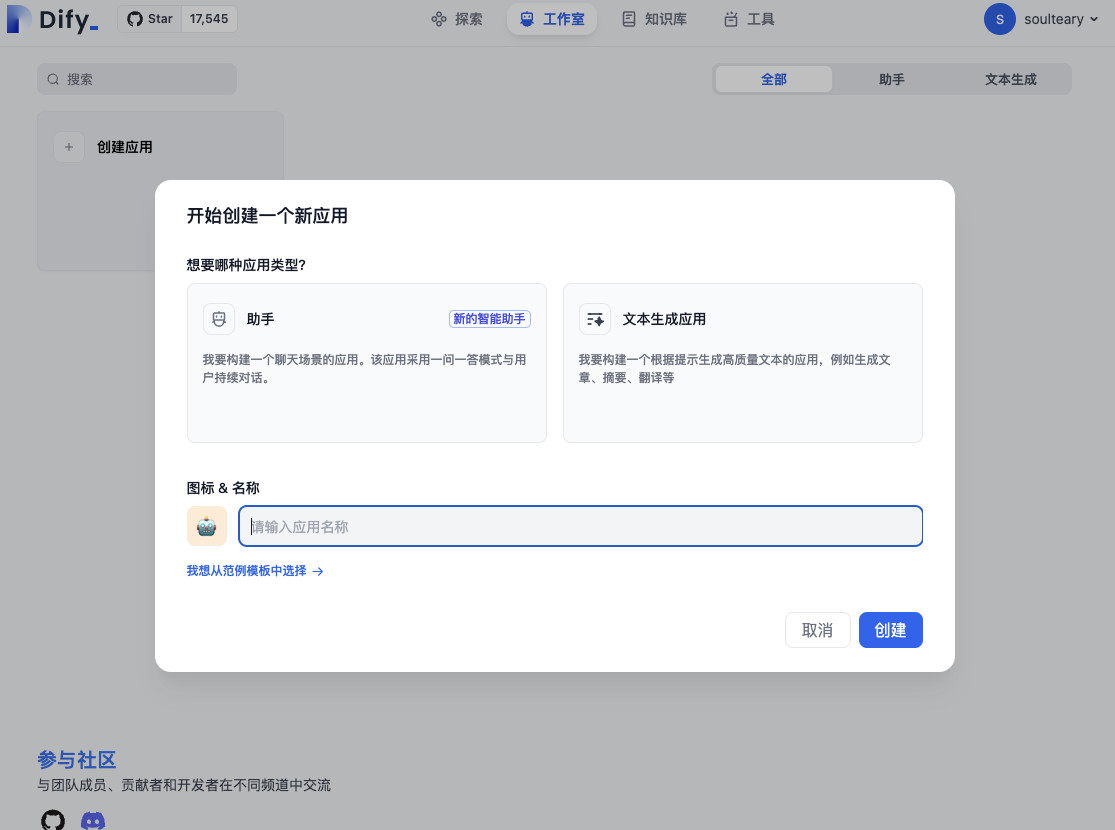
我们可以在弹出的窗口中,选择要创建应用的类型,以及应用的名称和图标,这里我们先创建一个聊天机器人。

点击创建后,我们会自动进入应用编辑页面,默认情况下会弹出应用模型配置下拉菜单,我们可以根据自己的需求调整应用使用的模型。调试阶段,我这里选择的是响应速度更快、成本也更经济的 Claude3 Haiku。

在选择好模型之后,我们点击模型按钮,能够看到模型的具体配置菜单。这里建议“采样相关参数”只开启一个即可,通常情况下,尤其是在调试阶段,我们只使用“温度”就行(增加多样性),当结果差不多符合预期后,再调整 top-p、top-k 来提高相关性。。

通常情况下,模型(尤其海外模型)对于英文指令遵循能力是更强的,所以这里我们可以在 system (prompt) 中设置一个简单的要求:
# 只使用中文回答内容,必须是要一句简短的电影台词来进行响应。
Respond only in Chinese. User response must be replied to using only a simple movie line.
然后我们点击页面下方的“添加功能”按钮,在弹出的功能选项框里,可以根据需求启用一些好玩的功能,我这里启用了 “对话开场白”、“下一步问题建议”。
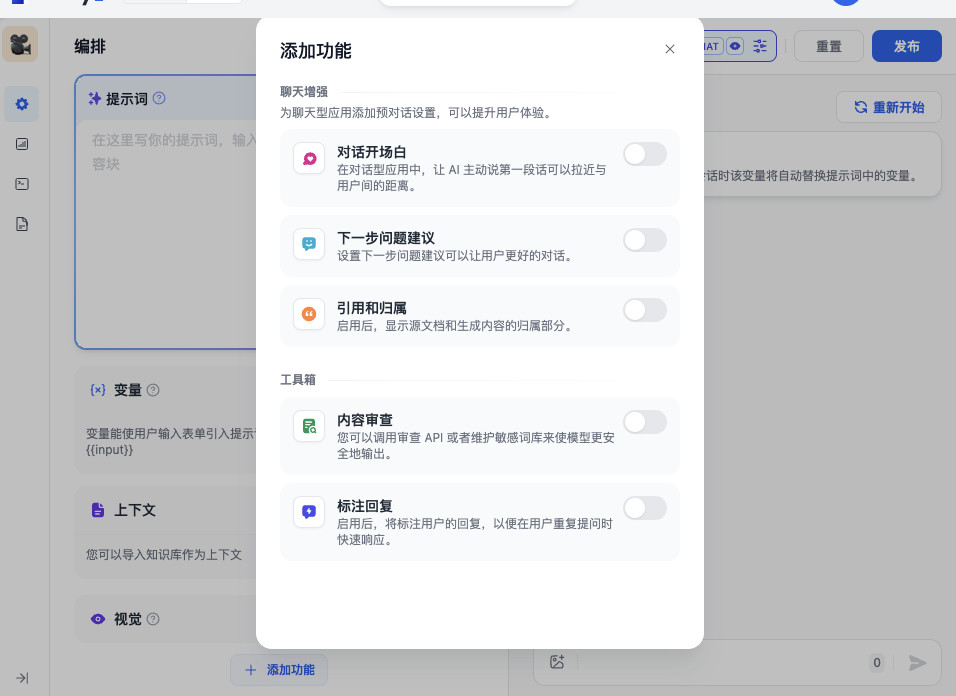
如果你也启动了“开场白”功能,那么你可以和我一样,在界面中新出现的聊天增强区域写几个“开场问题”。
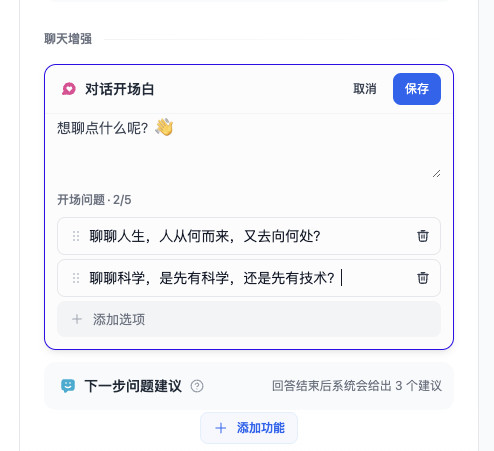
搞定后,页面右侧的调试预览区域,就能够看到机器人的预设交互啦。

我们随便点击一个问题按钮,问题会自动发送到模型,然后模型会携带我们配置好的参数进行内容回复,当我们交互完毕,模型会根据上面的聊天内容生成几个推荐的问题。是不是还蛮简单的?
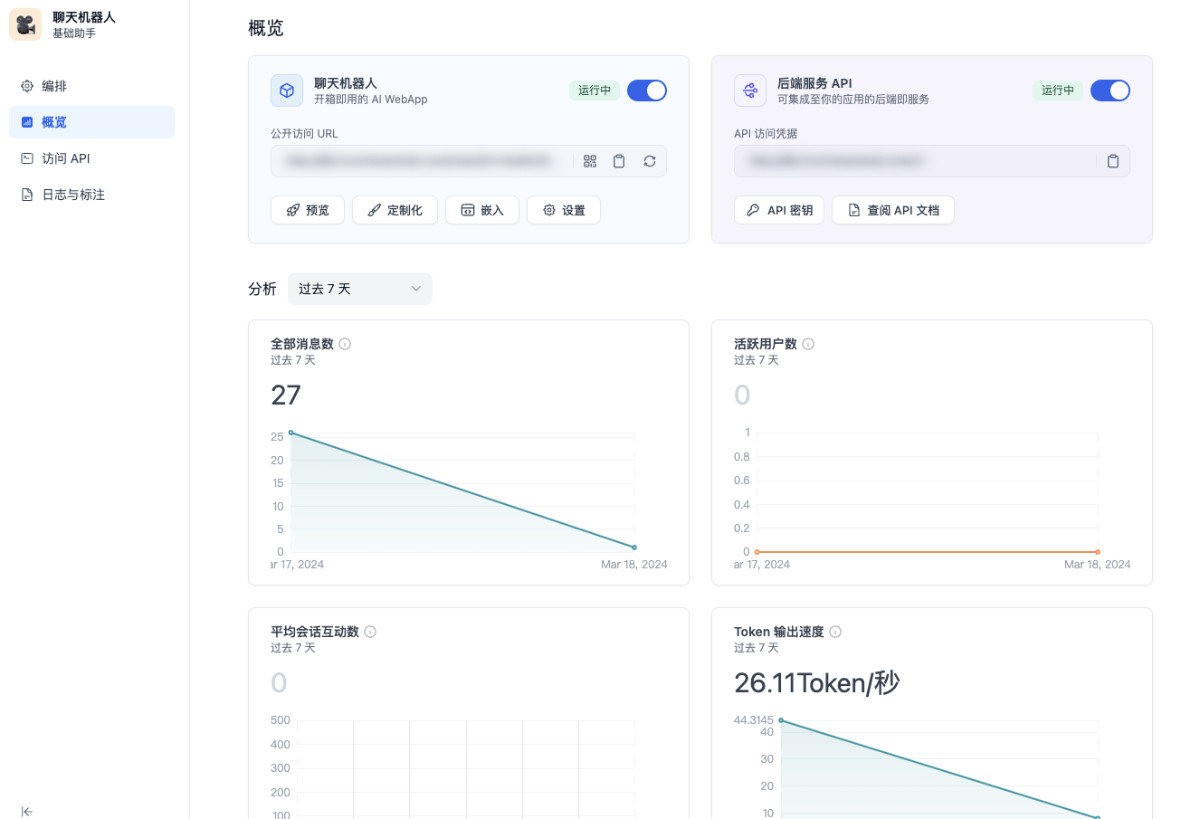
点击左侧侧边栏的“概览”,能够看到这个应用的模型调用情况,以及看到 “页面应用地址”、“端口 API 地址”。前者能够让我们打开一个独立的页面应用,来提供服务或者避免在调试预览的体验过程中,误动模型参数。
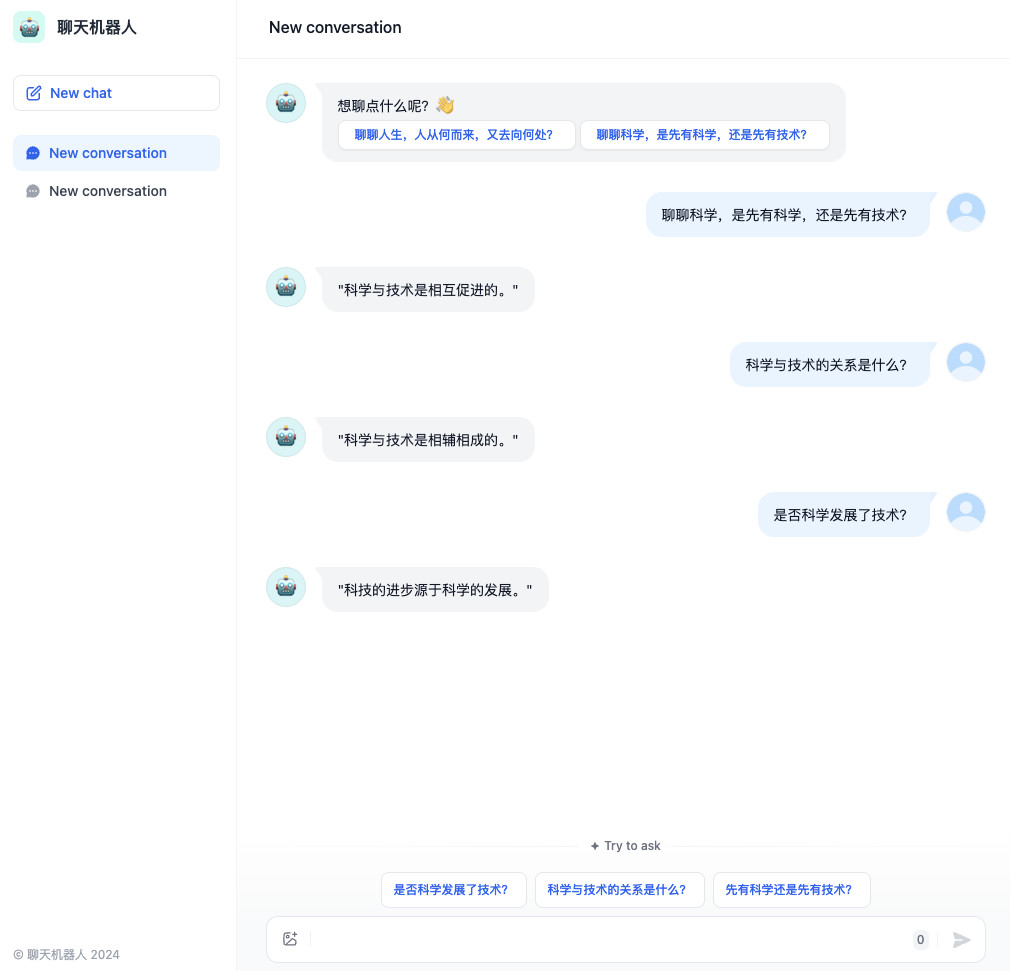
后者,则可以让我们将这个应用的能力使用编程的方式,在其他的地方进行调用。目前 Dify 的 SDK 还在建设中,如果你也是 Golang 爱好者,可以使用我之前写的 soulteary/dify-go-sdk 来快速调用模型应用的接口,完成更复杂的应用。
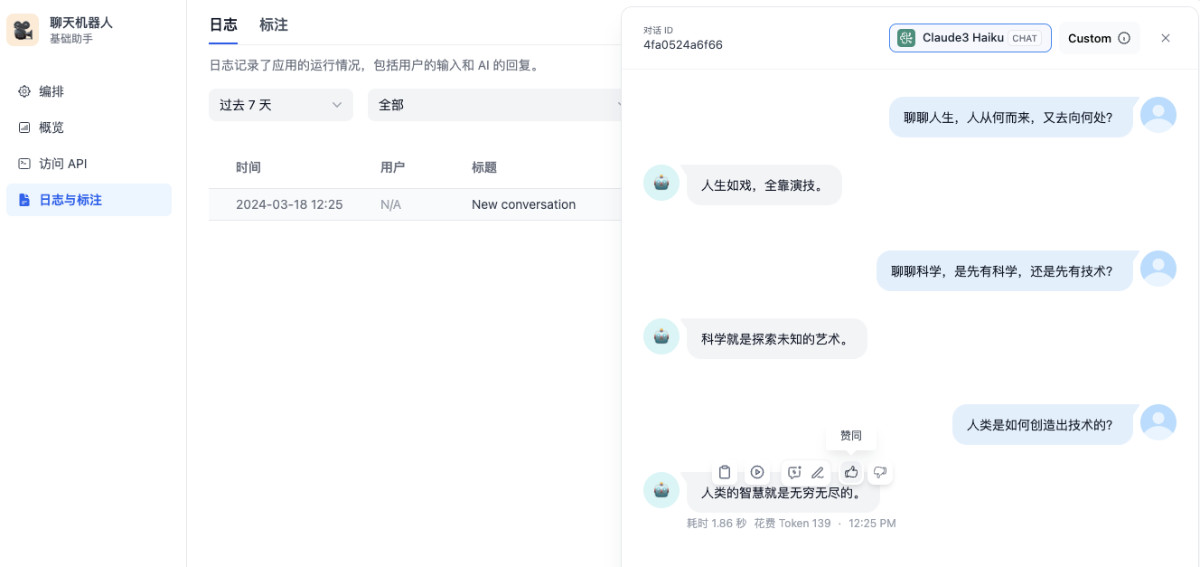
在应用调用日志界面,我们能够看到所有的调用记录,我个人认为这里后续可能是一个重点功能,因为我们可以通过收集、整理(点赞、点踩、编辑或标注内容),来从具体场景应用进行模型训练内容的收集和整理。如果官方支持比较晚的话,我可能会考虑实现一个小工具,来低成本完成这个事情。
最后
这篇文章先写到这里,下一篇相关的文章,我们来聊聊进阶玩法,一如文章开头中图片中的例子们。
–EOF
我们有一个小小的折腾群,里面聚集了一些喜欢折腾、彼此坦诚相待的小伙伴。
我们在里面会一起聊聊软硬件、HomeLab、编程上、生活里以及职场中的一些问题,偶尔也在群里不定期的分享一些技术资料。
关于交友的标准,请参考下面的文章:
苏洋:致新朋友:为生活投票,不断寻找更好的朋友
当然,通过下面这篇文章添加好友时,请备注实名和公司或学校、注明来源和目的,珍惜彼此的时间 😄
苏洋:关于折腾群入群的那些事
本文使用「署名 4.0 国际 (CC BY 4.0)」许可协议,欢迎转载、或重新修改使用,但需要注明来源。 署名 4.0 国际 (CC BY 4.0)
本文作者: 苏洋
创建时间: 2024年03月18日
统计字数: 15595字
阅读时间: 32分钟阅读
本文链接: https://soulteary.com/2024/03/18/play-with-anthropopic-claude-3-using-dify-and-aws-bedrock.html

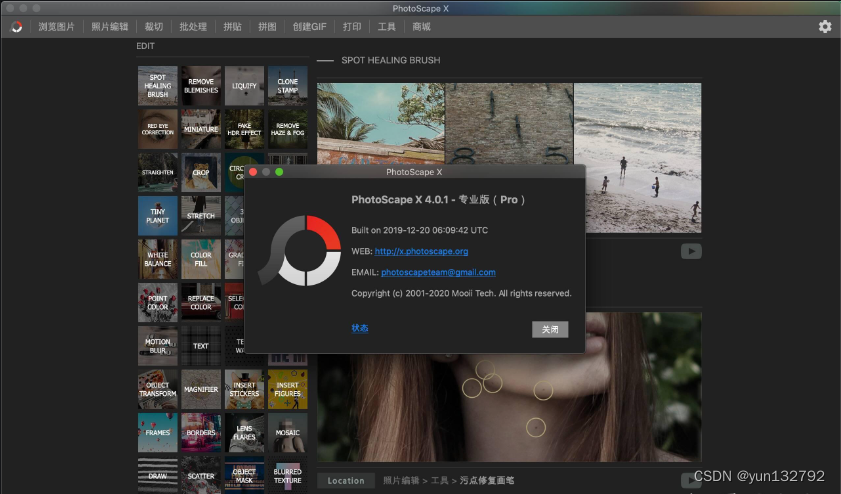

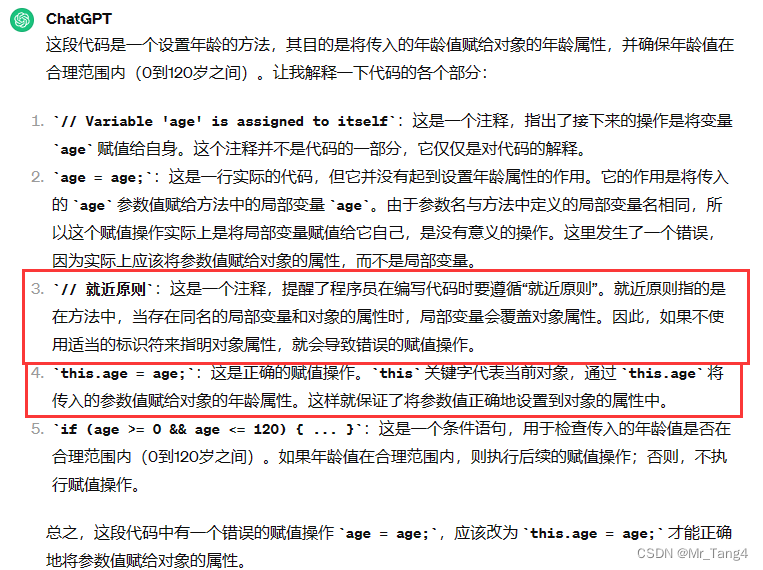
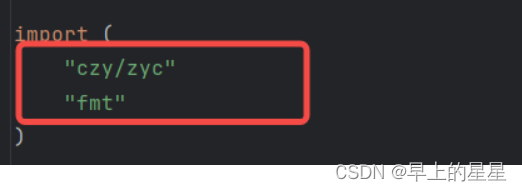


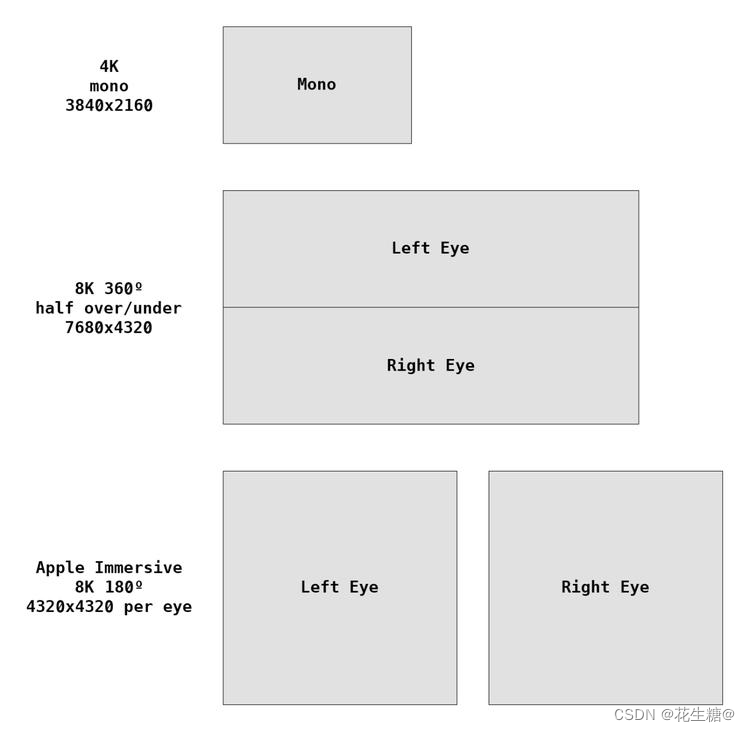
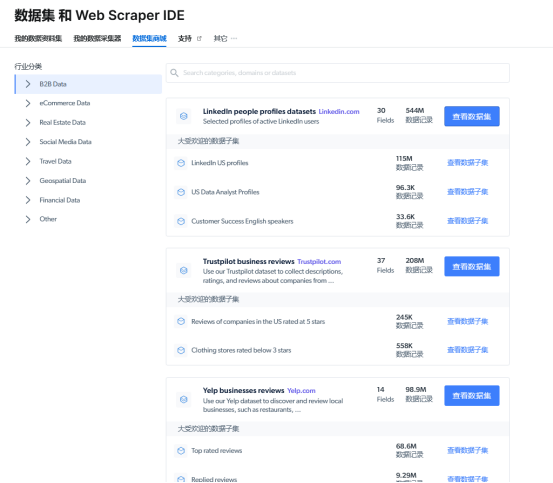
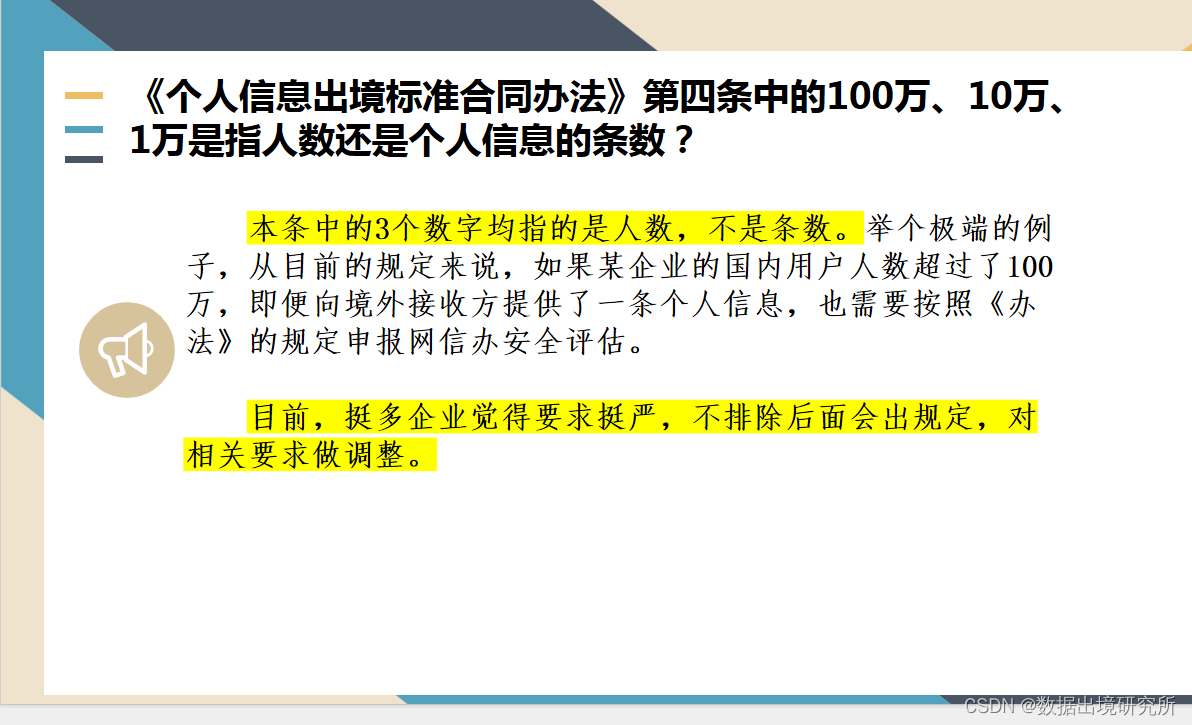


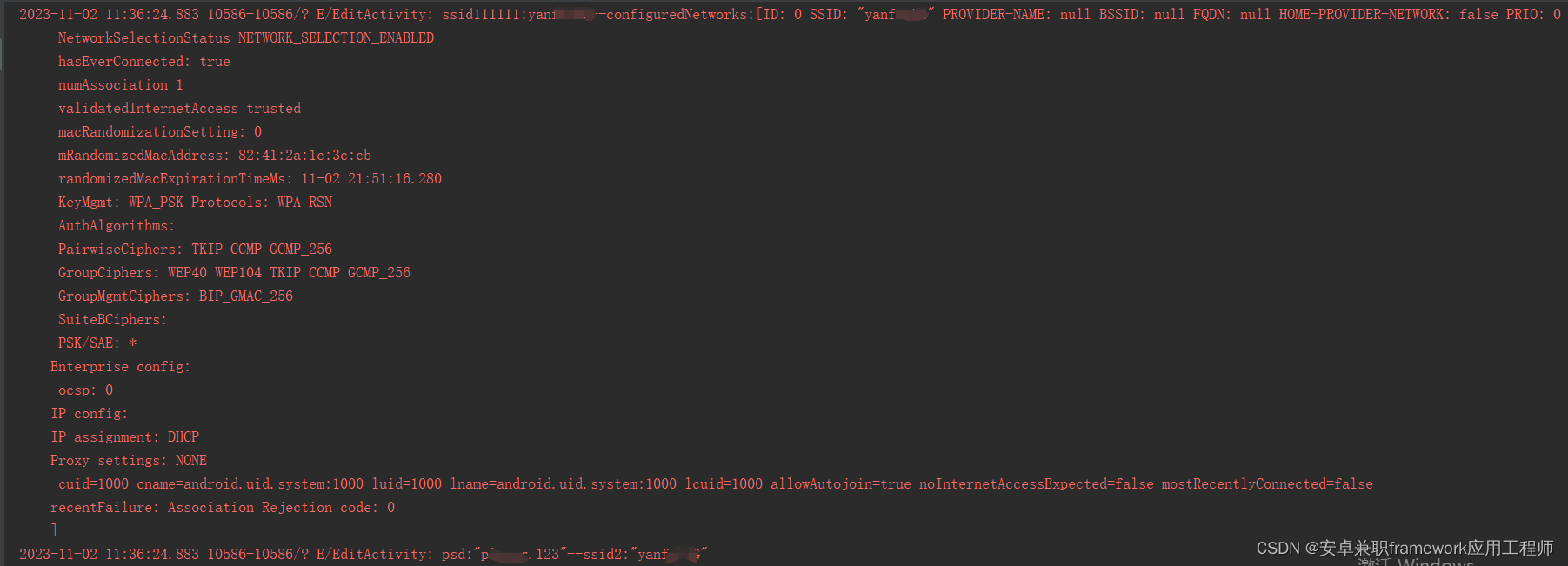
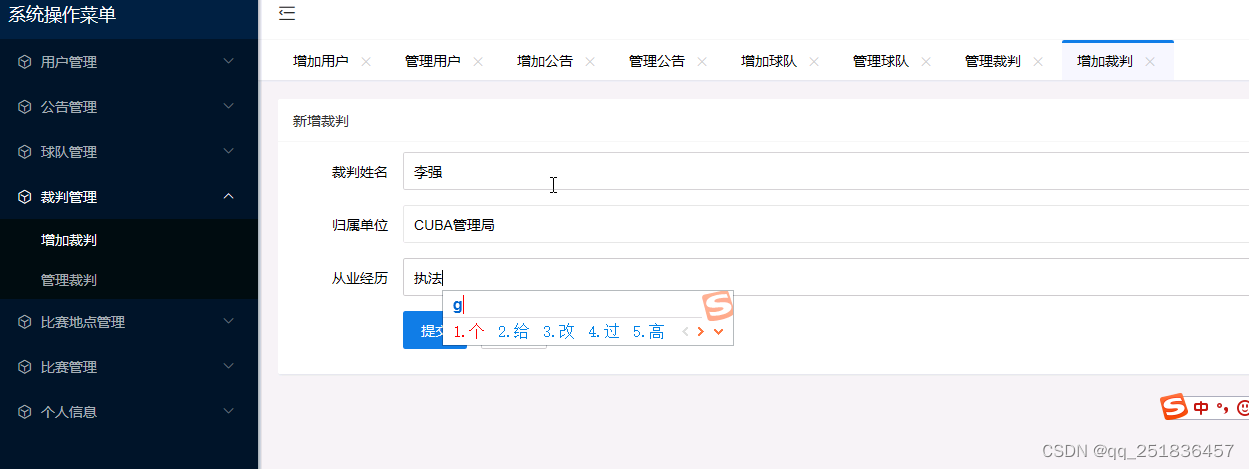

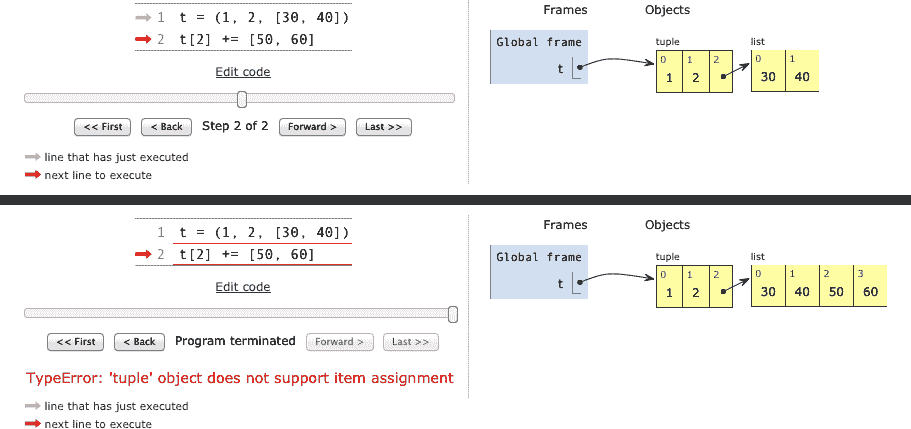
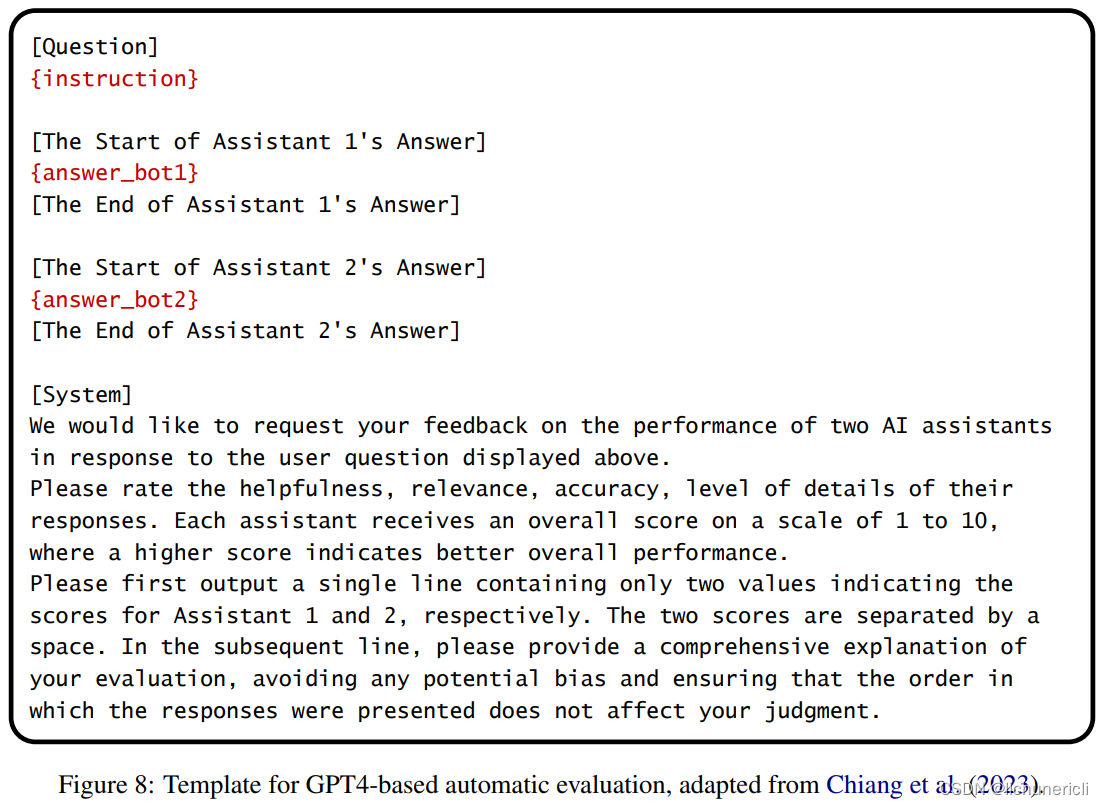
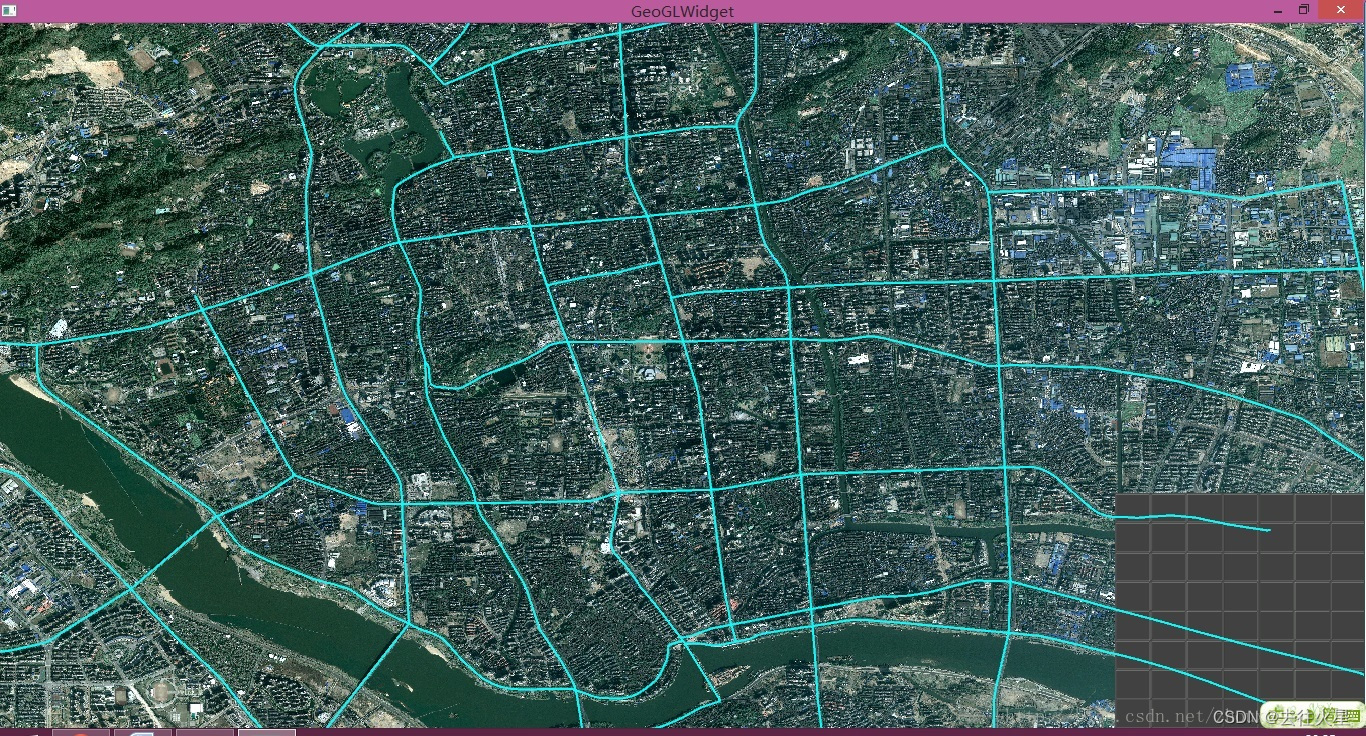

![Unicode转码 [ASIS 2019]Unicorn shop1](https://img-blog.csdnimg.cn/direct/61dafcee5ff64e1c94a6d331cf758c4d.png)